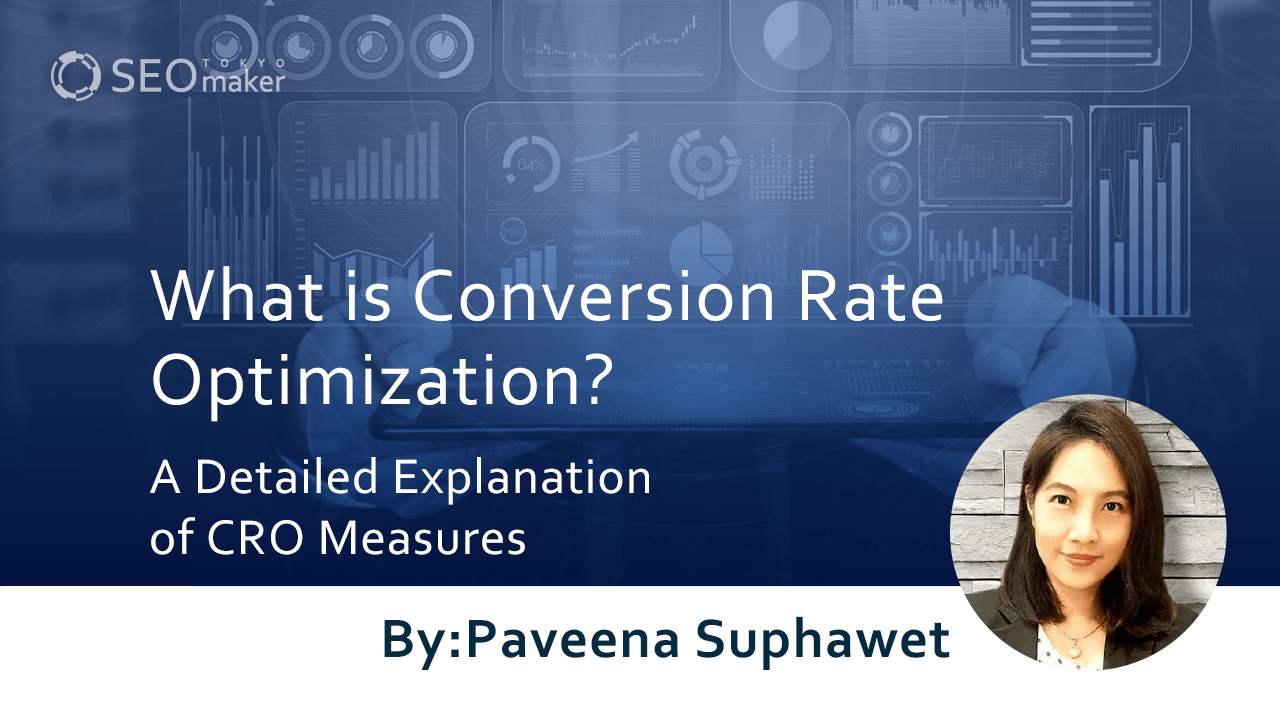What is Conversion Rate Optimization? A Detailed Explanation of CRO Measures
contents
- 1 What is Conversion Rate Optimization (CRO)?
- 2 Key CRO Strategies
- 2.1 A/B Testing
- 2.2 Conversion Path Improvement
- 2.3 CTA Improvement
- 2.4 Improvement Points to Increase Conversion Numbers
- 2.5 Homepage
- 2.6 Lead Generation Pathways
- 2.7 Intermediate Pages
- 2.8 Entry Forms
- 2.9 Introduction of Chatbots
- 2.10 The Process of CRO
- 2.11 Formulating a Hypothesis
- 2.12 Conducting A/B Testing
- 2.13 Analyzing Results
- 2.14 Repeating the Process
- 3 Points to Consider in CRO
- 4 Parallel Implementation with SEO
 SEO and web advertising aim to increase site traffic. However, these are means to an end, not the end itself.
SEO and web advertising aim to increase site traffic. However, these are means to an end, not the end itself.
Ultimately, most goals involve increasing sales. To boost sales on the web, it’s essential to increase inquiries. Thus, SEO and web advertising are merely means to increase inquiries, and a significant challenge for web managers is to increase the number of conversions.
We explains Conversion Rate Optimization (CRO) in this article.
What is Conversion Rate Optimization (CRO)?
Conversion Rate Optimization (CRO) is, as the name suggests, optimizing (increasing) the conversion rate. In other words, CRO refers to web strategies that increase the number of conversions. Understanding CRO requires knowledge of CV and CVR.
What is CV (Conversion)?
In digital marketing, Conversion (CV) means achieving a goal. For an e-commerce site, the goal is a product purchase; for a corporate site, it might be inquiries, membership registrations, requests for materials, or job applications.
Many websites are also setting micro-conversions as intermediate goals towards achieving conversions, such as downloading white papers or subscribing to newsletters.
What is CVR (Conversion Rate)?
Conversion Rate (CVR) refers to the ratio of users who have accessed a website and achieved a conversion. If 5 out of 100 users convert, the CVR is 5%.
SEO and web advertising are meaningless if they don’t lead to conversions. Therefore, web managers need to devise strategies to increase CVR alongside SEO and web advertising.
Generally, a CVR of 1% (1 conversion per 100 accesses) is considered decent.
How to Increase CVs (Number of Conversions)
The goal of a website is to increase the number of conversions (CVs). There are mainly two ways to do this:
- SEO or Web Advertising
- CRO
SEO and web advertising increase site traffic. More traffic naturally increases the probability of inquiries, thus increasing conversions.
However, SEO takes time to show effects, and continuous web advertising incurs costs. Therefore, to enhance cost-effectiveness, it’s desirable to implement CRO (Conversion Rate Optimization) to increase inquiries.
Strategies to Implement Alongside CRO
While broadly included in CRO, there are specific strategies that should be implemented alongside CRO, namely LPO and EFO. Both are essential terms to remember.
LPO (Landing Page Optimization)
LPO means optimizing the LP (Landing Page). The LP is the first page a user lands on from natural search engines or web advertising. The first view of the LP should capture the user’s attention, leading them through the content to conversion.
If the LP gives a negative impression, such as being hard to read or understand, users will quickly leave, making LP optimization crucial for increasing conversions.
EFO (Entry Form Optimization)
EFO means optimizing the entry form. Forms for inquiries or requests for materials can lose potential customers if they are confusing or have too many fields.
Losing users at the entry form stage is a significant loss, so testing and ensuring a stress-free form design is an effective method to increase conversions.
Key CRO Strategies
There are many CRO strategies, but here are three representative ones:
- A/B Testing
- Conversion Path Improvement
- CTA Improvement
A/B Testing
A/B Testing involves creating two nearly identical pages with specific changes to determine which has a higher CVR.
Even minor changes, like the color, placement, or wording of the conversion button, can significantly impact CVR. The goal is to increase trial frequency, refine accuracy, and find the winning pattern.
Conversion Path Improvement
This involves analyzing the paths taken by users who have converted to identify which paths lead to more conversions.
Whether through SEO or web advertising, analyzing the pages users navigate through from landing to conversion can reveal high-CVR paths, allowing for improved content and landing page guidance.
CTA Improvement
CTA stands for Call to Action. A site should have banners, buttons, and phrases to prompt user action at the beginning, middle, end, sidebar, and following buttons.
Revising the color, wording, and placement of these CTA elements can increase the number of users guided to the entry form, thereby enhancing CVR.
Improvement Points to Increase Conversion Numbers
To increase conversion numbers, various measures are necessary. However, for large-scale pages, addressing numerous pages becomes inefficient.
Therefore, it’s essential to identify key points and prioritize them for effective response. The priority of pages to focus on varies by site and industry, but in most cases, the following pages are of high importance:
- Homepage
- Lead generation pathways
- Intermediate pages
- Entry forms
- Introduction of chatbots
Homepage
For many sites, the homepage typically receives the most landing numbers. Thus, guiding users from the homepage to the pages they seek is crucial.
While it’s essential to clearly establish pathways from the homepage to key pages, correctly guiding users to pages with high conversion rates (CVR) can optimize the entire site.
Lead Generation Pathways
In a standard site, conversions usually occur after navigating through several pages from the landing page. The nature of these intermediate pages is crucial.
Users search with specific queries and access sites, but it’s a wasted opportunity if they only gather information and leave. While it’s understandable if users are solely focused on information gathering, if the lack of designed pathways is the issue, simply providing appropriate transition destinations can potentially improve CVR.
Intermediate Pages
Once pathways are set and users start transitioning, it’s important to ensure they can move to the desired information and that the pathways are clear. Providing a user-friendly UI/UX is a significant aspect of pathway design, so consider how to lead users to high-CVR intermediate pages.
Entry Forms
When users are convinced by the service content and pricing, they move to the entry form. It’s counterproductive if users leave at this stage due to the form’s complexity or unclear elements. Since these users have already reached the form, it’s crucial to ensure they convert without fail.
Introduction of Chatbots
While not limited to chatbots, numerous reports suggest that web customer service tools contribute to CVR improvement. Particularly, the CVR improvement with chatbots is remarkable, and in some industries, their presence can significantly impact sales.
Rather than simply adding a chatbot, it’s crucial to thoroughly consider how to design a user-friendly experience.
The Process of CRO
Achieving success in Conversion Rate Optimization (CRO) is challenging, but it’s vital to build on the basics and accumulate efforts. Giving up after one or two failures is not an option; it’s about creating a winning pattern for your company through hundreds or thousands of trials.
For this, repeat the following process of hypothesis and verification:
Formulating a Hypothesis
The first step is to formulate a hypothesis. Understand the current situation correctly to base your next measures and gain a foundation for implementation.
Consider the following factors:
- PV: Page Views
- UU: Unique Users
- CVs: Conversion Numbers
- Bounce Rate: The rate at which users leave without any interaction
Keep track of what was improved and why, and use this information for your next hypothesis.
Conducting A/B Testing
After formulating a hypothesis and identifying improvement areas, test them out and observe the results. In A/B testing, prepare two versions of a page with slight changes and compare the outcomes.
Pay attention to the measurement period or the number of accesses during this period. If sufficient data is not obtained despite a set period, it indicates the period was too short. However, relying solely on access numbers can be misleading if access fluctuations are seasonal.
Analyzing Results
After completing A/B testing, compare the data to see how it has changed. Significant results may or may not appear, and whether they do or not, it’s crucial to investigate why.
Repeating the Process
CRO is never a one-time process. Increasing the number of trials improves accuracy, so as long as there are hypotheses, it’s important to keep repeating the process.
Points to Consider in CRO
While CRO (Conversion Rate Optimization) is undoubtedly a beneficial strategy, there are important considerations to keep in mind.
Do Not Make Short-Term Judgments
CRO is not a short-term endeavor. It requires ongoing effort until results are seen, and even after achieving results, it’s essential to continually seek further improvements.
Resource Requirements
CRO involves repeated, detailed adjustments, making the initial hypothesis crucial. Formulating a hypothesis, implementing it, and analyzing the results require significant financial and human resources. Proper personnel allocation is necessary for successful CRO, as it cannot be achieved without the right expertise.
Parallel Implementation with SEO
While this article has focused on CRO, it’s important to remember that CRO is a method for handling users who have already accessed your site. Increasing the number of site visits is also a vital strategy for increasing conversions. The most common methods for increasing site visits are advertising and SEO. Considering the long-term perspective and the ability to produce multiple landing pages, it’s necessary to implement SEO in parallel with CRO. By increasing access, creating pages for each search need, and optimizing each page for conversions, a stronger site can be developed. Optimizing user pathways often ties into SEO, so it’s crucial to pursue both strategies concurrently.
Summary
Conversion Rate Optimization (CRO) is a process aimed at enhancing the proportion of website visitors who perform a specific action, known as a conversion. This includes actions such as making a purchase on an e-commerce site or submitting an inquiry on a corporate site. CRO focuses on improving the Conversion Rate (CVR) by refining various elements of the website. Key methods include increasing traffic through SEO and web advertising, optimizing Landing Pages (LPO), and refining Entry Forms (EFO). Strategies in CRO involve comparing pages via A/B testing, enhancing conversion paths, and optimizing Calls to Action (CTA). These strategies are designed to effectively guide users through the site, encouraging them to take the desired action. CRO is an ongoing process that requires iterative experimentation to find the most effective pattern. Implementing CRO in conjunction with SEO can simultaneously increase site visitors and improve the site’s conversion rate.










![What is a Description? Explaining the Meaning, Writing Style, and Changing Word Count – [2023 Edition]](https://www.switchitmaker2.com/en/wp-content/uploads/2024/09/what-is-description.webp)










